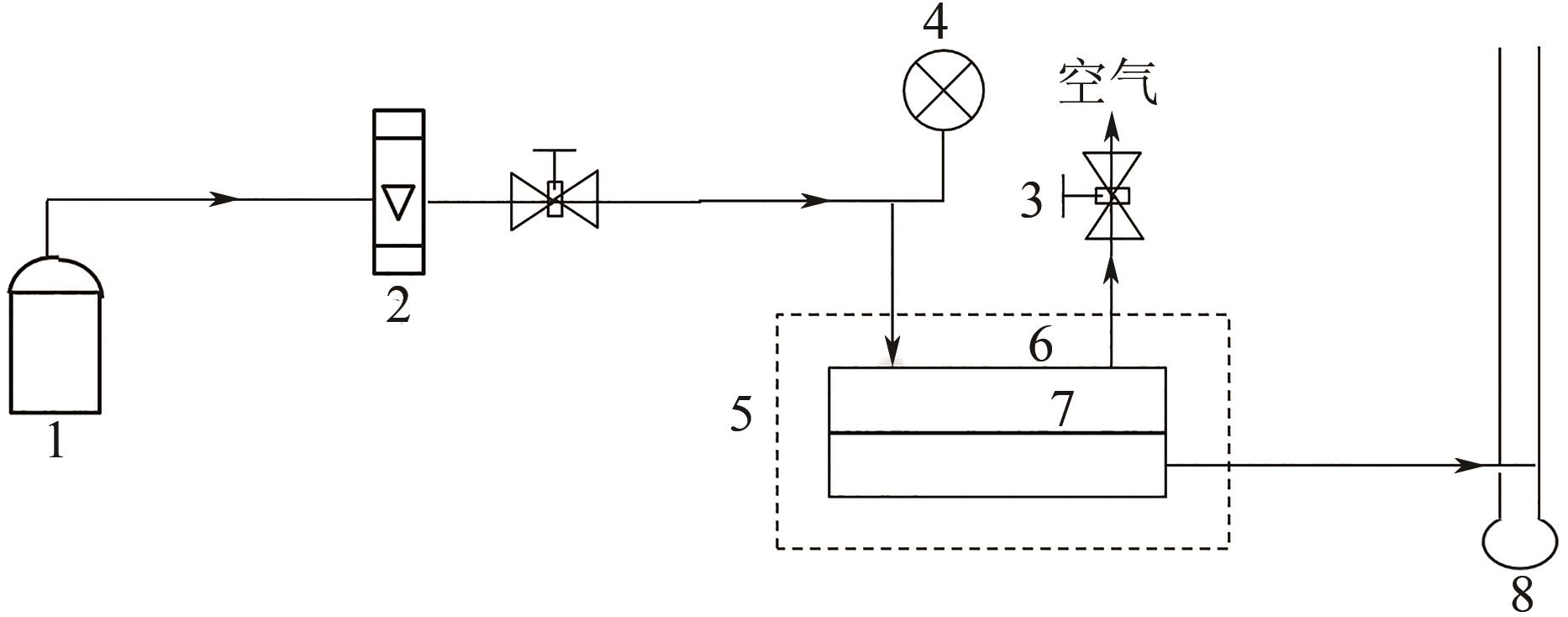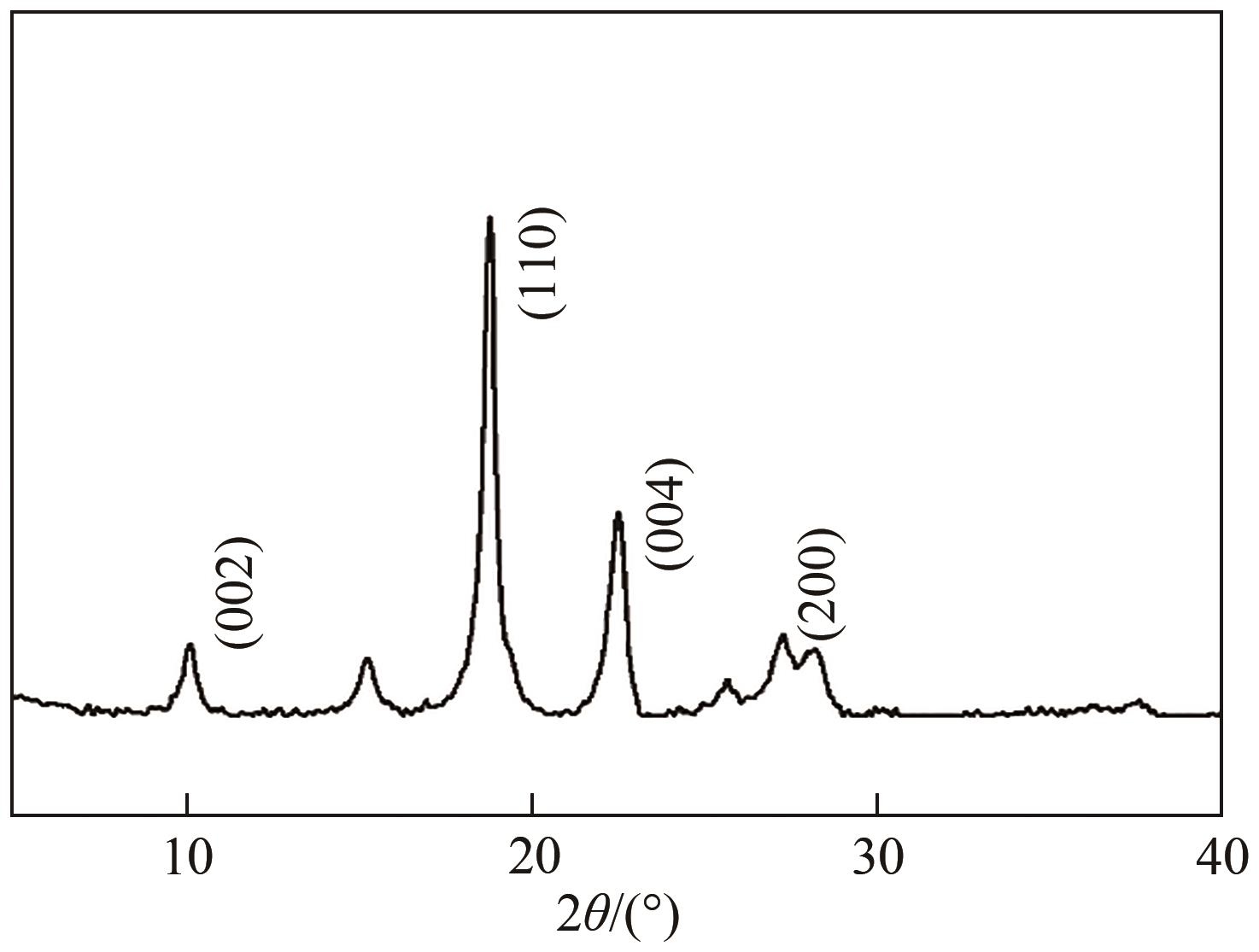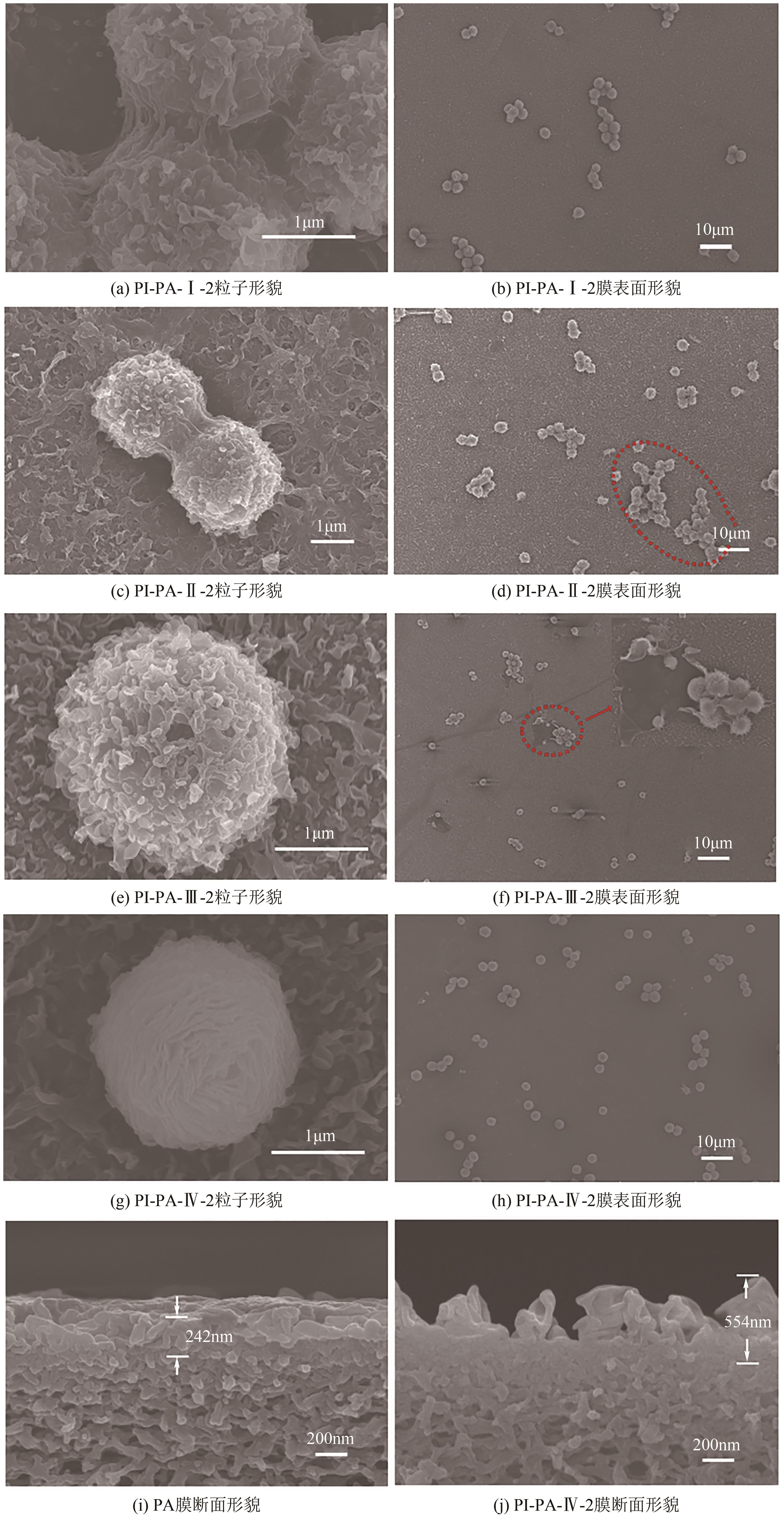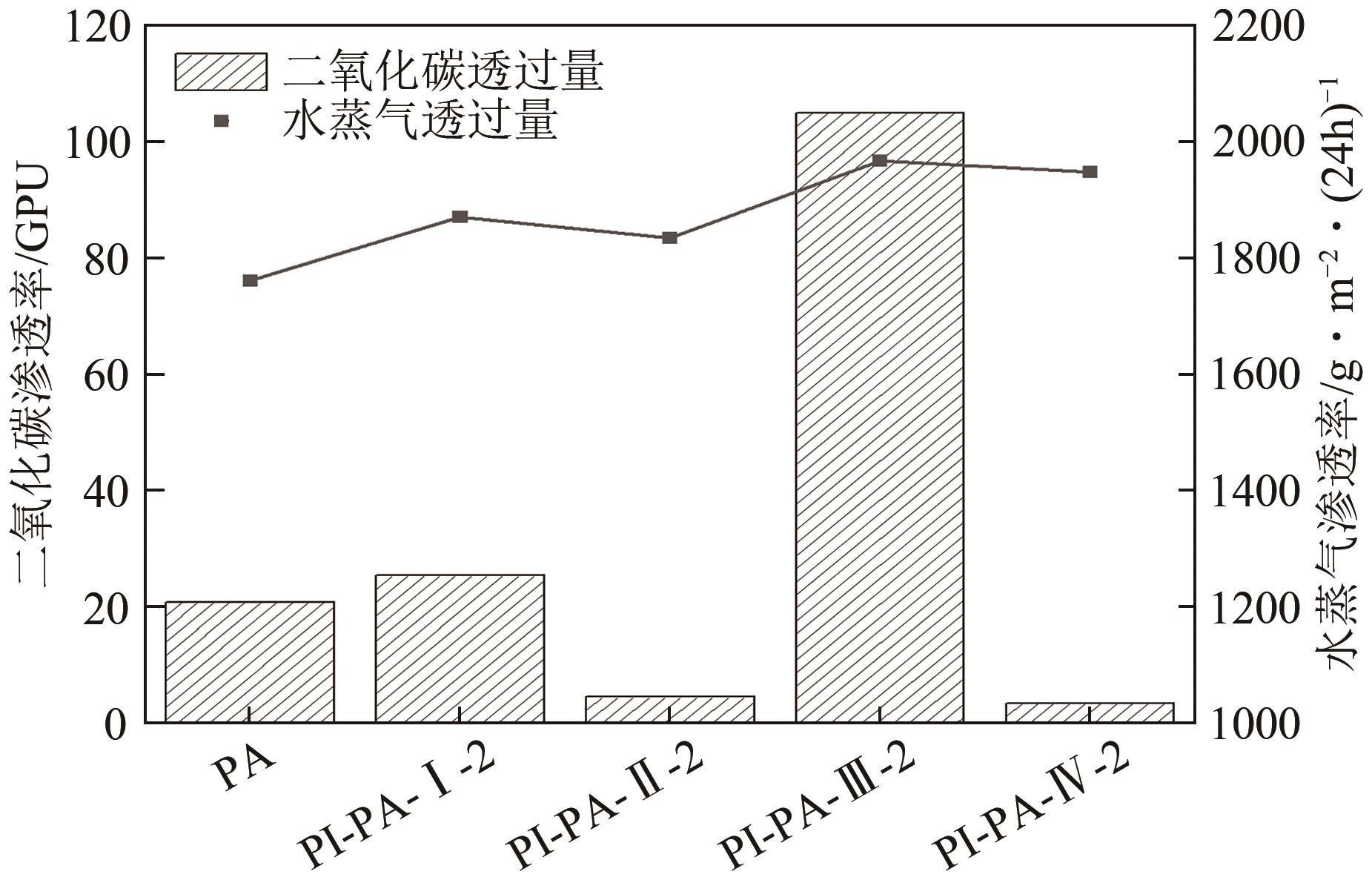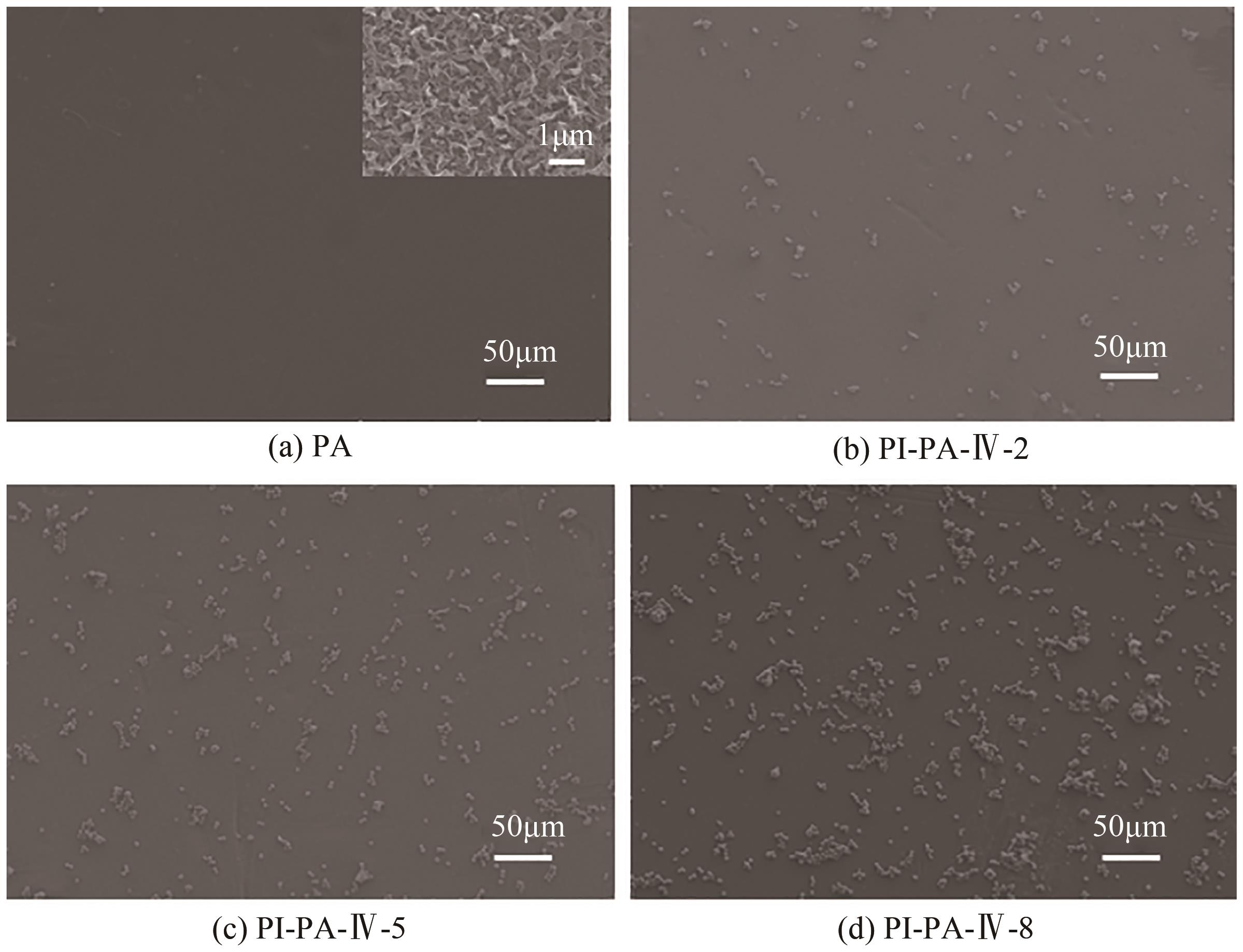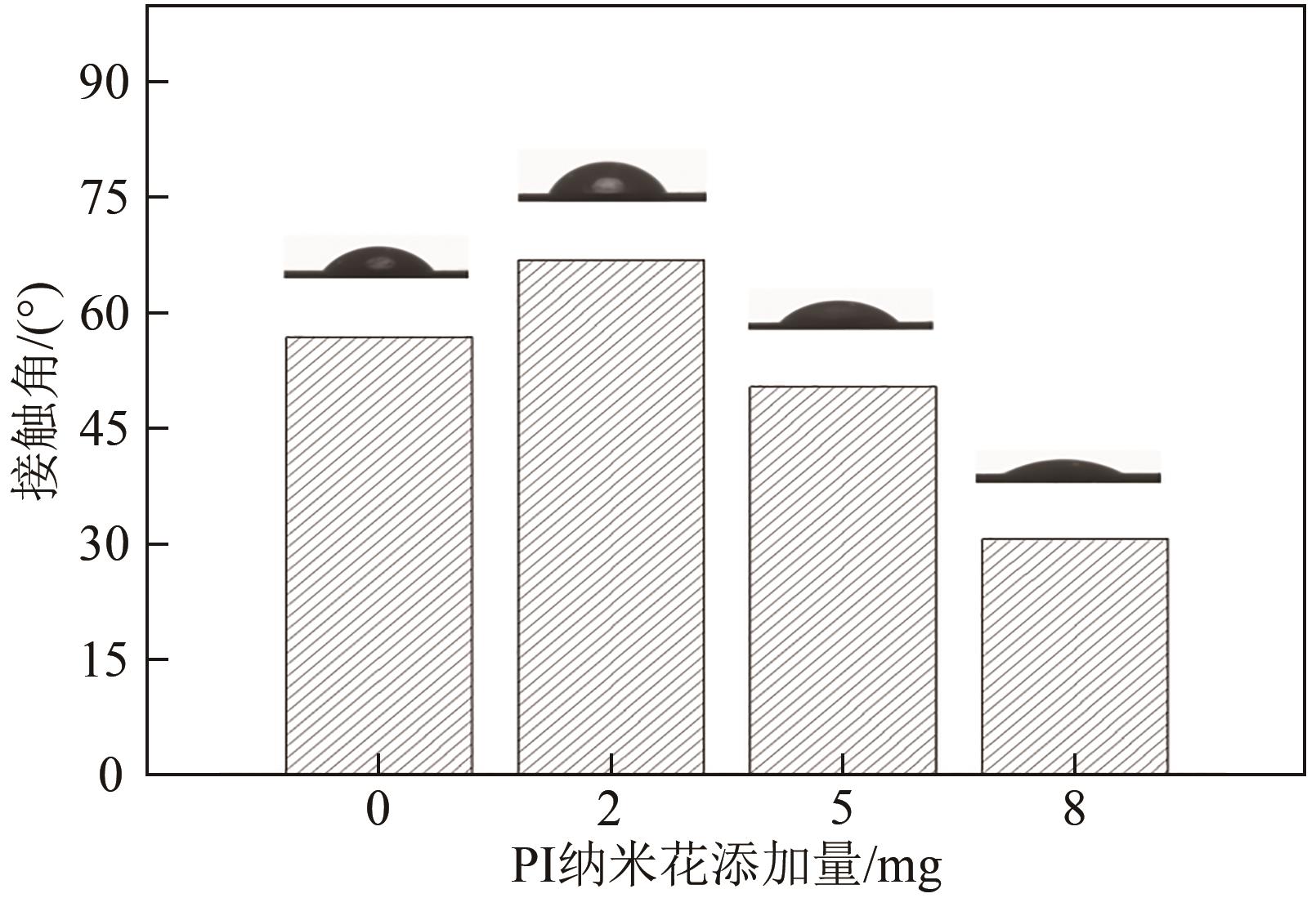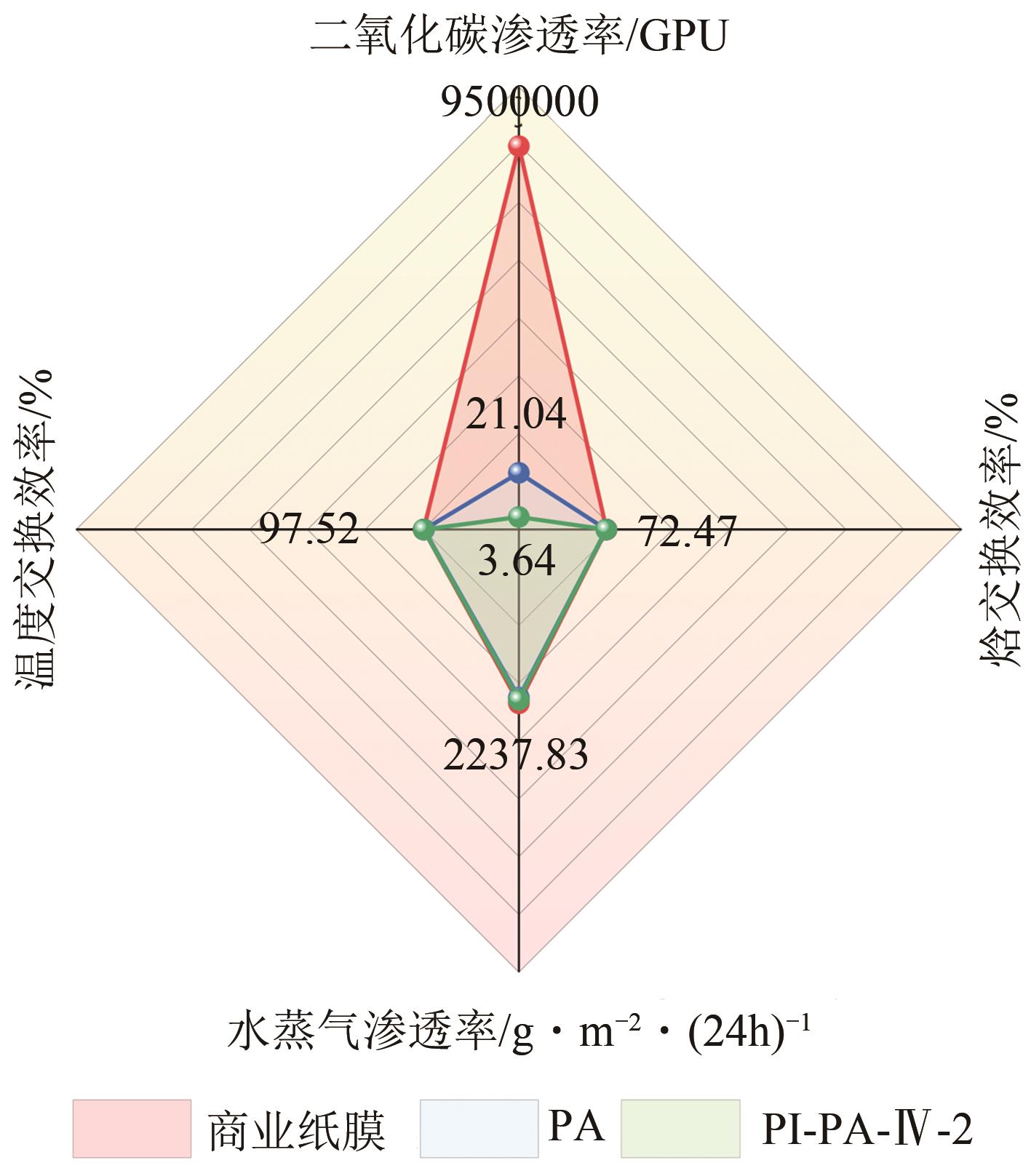化工进展 ›› 2023, Vol. 42 ›› Issue (12): 6478-6489.DOI: 10.16085/j.issn.1000-6613.2023-0101
• 材料科学与技术 • 上一篇
基于PI微球复合型全热交换膜的制备与性能
罗伶萍1( ), 王慧敏1, 朱泰忠1, 张良1, 刘梦娇1, 黄菲1(
), 王慧敏1, 朱泰忠1, 张良1, 刘梦娇1, 黄菲1( ), 薛立新1,2(
), 薛立新1,2( )
)
- 1.浙江工业大学化工学院膜分离与水科学技术中心,浙江 杭州 310014
2.温州大学化学与材料工程学院,浙江 温州 325035
-
收稿日期:2023-01-29修回日期:2023-03-04出版日期:2023-12-25发布日期:2024-01-08 -
通讯作者:黄菲,薛立新 -
作者简介:罗伶萍(1997—),女,硕士研究生,研究方向为膜科学与技术。E-mail:2112001153@zjut.edu.cn。 -
基金资助:国家自然科学基金(NSFC-21975222)
Preparation and properties of composite total heat exchange membranes based on polyimide microspheres
LUO Lingping1( ), WANG Huimin1, ZHU Taizhong1, ZHANG Liang1, LIU Mengjiao1, HUANG Fei1(
), WANG Huimin1, ZHU Taizhong1, ZHANG Liang1, LIU Mengjiao1, HUANG Fei1( ), XUE Lixin1,2(
), XUE Lixin1,2( )
)
- 1.Center for Membrane Separation and Water Science & Technology, College of Chemical Engineering, Zhejiang University of Technology, Hangzhou 310014, Zhejiang, China
2.College of Chemistry and Materials Engineering, Wenzhou University, Wenzhou 325035, Zhejiang, China
-
Received:2023-01-29Revised:2023-03-04Online:2023-12-25Published:2024-01-08 -
Contact:HUANG Fei, XUE Lixin
摘要:
聚酰亚胺(PI)是一类具备高热稳定性和化学稳定性的聚合物材料,已被广泛用于气体分离膜的制备。然而,当前将其作为新型有机填料的研究甚少,更没有应用在全热交换、新风系统领域的相关报道。因此,本文采用对苯二胺(pPDA)和3,3′,4,4′-二苯酮四甲酸二酐(BTDA)作为单体原料,通过溶剂热聚合法成功制备了具有片层结构的PI微球颗粒。通过界面聚合过程将所制备的PI微球引入聚酰胺(PA)分离层中,构建出一系列基于PI微球的PA复合型全热交换膜材料。深入探究了PI微球的添加方式(制膜工艺)和掺杂量对膜形貌、水接触角、表面粗糙度、CO2及水蒸气透过率、全热交换效率等的影响规律。研究结果表明,采用将PI微球均匀分散于均苯三甲酰氯(TMC)油相溶液中的制膜方法可确保粒子的负载与界面聚合反应同步进行,有效避免了颗粒堆叠和界面缺陷的问题。所制备的PI-PA-IV-2复合膜具有优异的透湿阻气性能,水蒸气渗透率从原膜的1763.45g/(m2·24h)提升至1949.51g/(m2·24h),CO2透过率从21.04GPU降至3.64GPU。与此同时,该膜拥有与商业纸膜相当的热交换效率(97.47%)和焓交换效率(71.41%),为新型高效全热交换膜的制备提供了可行方案。
中图分类号:
引用本文
罗伶萍, 王慧敏, 朱泰忠, 张良, 刘梦娇, 黄菲, 薛立新. 基于PI微球复合型全热交换膜的制备与性能[J]. 化工进展, 2023, 42(12): 6478-6489.
LUO Lingping, WANG Huimin, ZHU Taizhong, ZHANG Liang, LIU Mengjiao, HUANG Fei, XUE Lixin. Preparation and properties of composite total heat exchange membranes based on polyimide microspheres[J]. Chemical Industry and Engineering Progress, 2023, 42(12): 6478-6489.
| 添加量/mg | 粗糙度/ |
|---|---|
| 0 | 0.48 |
| 2 | 0.47 |
| 5 | 0.56 |
| 8 | 0.79 |
表1 添加不同含量微球的PI-PA复合膜粗糙度
| 添加量/mg | 粗糙度/ |
|---|---|
| 0 | 0.48 |
| 2 | 0.47 |
| 5 | 0.56 |
| 8 | 0.79 |
| 膜类型 | 热交换效率/% | 焓交换效率/% | 二氧化碳渗透率/GPU | 水蒸气渗透率/g·m-2·(24h)-1 |
|---|---|---|---|---|
| 商业纸膜 | 97.52 | 72.47 | 9.5×106 | 2237.83 |
| PA | 95.59 | 71.43 | 21.04 | 1763.45 |
| PI-PA-Ⅳ-2 | 97.47 | 71.41 | 3.64 | 1949.51 |
表2 膜的热交换效率、焓交换效率及透湿阻气性
| 膜类型 | 热交换效率/% | 焓交换效率/% | 二氧化碳渗透率/GPU | 水蒸气渗透率/g·m-2·(24h)-1 |
|---|---|---|---|---|
| 商业纸膜 | 97.52 | 72.47 | 9.5×106 | 2237.83 |
| PA | 95.59 | 71.43 | 21.04 | 1763.45 |
| PI-PA-Ⅳ-2 | 97.47 | 71.41 | 3.64 | 1949.51 |
| 1 | HONG Tianzhen, CHEN Yixing, LUO Xuan, et al. Ten questions on urban building energy modeling[J]. Building and Environment, 2020, 168: 106508. |
| 2 | LI Zhengdao, ZHANG Limei, LIANG Xin, et al. Advances in the research of building energy saving[J]. Energy and Buildings, 2022, 254: 111556. |
| 3 | ARIDI Rima, FARAJ Jalal, Samer ALI, et al. A comprehensive review on hybrid heat recovery systems: Classifications, applications, pros and cons, and new systems[J]. Renewable and Sustainable Energy Reviews, 2022, 167: 112669. |
| 4 | CHEN Yulu, OZAKI Akihito, LEE Haksung. Energy saving potential of passive dehumidification system combined with energy recovery ventilation using renewable energy[J]. Energy and Buildings, 2022, 268: 112170. |
| 5 | PEI Xiang. Application of exhaust heat recovery in energy saving of HVAC[J]. IOP Conference Series: Earth and Environmental Science. IOP Publishing, 2019, 295(5): 052009. |
| 6 | 张炎, 张立志, 项辉, 等. 基于亲水/憎水复合膜的全热交换器换热换湿性能[J]. 化工学报, 2007, 58(2): 294-298. |
| ZHANG Yan, ZHANG Lizhi, XIANG Hui, et al. Performance of heat and mass transfer based on hydrophilic/hydrophobic composite membrane[J]. Journal of Chemical Industry and Engineering (China), 2007, 58(2): 294-298. | |
| 7 | 孔令健, 高晓坤, 刘广哲, 等. 高分子膜式新风机组换热特性研究[J]. 制冷与空调, 2023, 23(5): 86-89. |
| KONG Lingjian, GAO Xiaokun, LIU Guangzhe, et al. Study on heat transfer characteristcs of polymer membrane-based outdoor air handling unit[J]. Refrigeration and Air-conditioning, 2023, 23(5): 86-89. | |
| 8 | ZHANG Xinru, ZHANG Lizhi, LIU Hongmei, et al. One-step fabrication and analysis of an asymmetric cellulose acetate membrane for heat and moisture recovery[J]. Journal of Membrane Science, 2011, 366(1/2): 158-165. |
| 9 | Neda ASASIAN-KOLUR, SHARIFIAN Seyedmehdi, HADDADI Bahram, et al. Membrane-based enthalpy exchangers for coincident sensible and latent heat recovery[J]. Energy Conversion and Management, 2022, 253: 115144. |
| 10 | FANG Lei, YUAN Shu, NIE Jinzhe. Experimental evaluation of a total heat recovery unit with polymer membrane foils[C]//Proceedings of the 8th International Symposium on Heating, Ventilation and Air Conditioning. Berlin, Heidelberg: Springer, 2014: 235-242. |
| 11 | 聂金哲, 李赞, 张群力, 等. 全热回收新风机组二次携带污染物风险测试及分析[J]. 建筑科学, 2017, 33(8): 17-22. |
| NIE Jinzhe, LI Zan, ZHANG Qunli, et al. Risk test and analysis of secondary pollutants carried by total heat recovery fresh air unit[J]. Building Science, 2017, 33(8): 17-22, 28. | |
| 12 | KHOONSAP Santi, AMNUAYPANICH Sittipong. Mixed matrix membranes prepared from poly(vinyl alcohol) (PVA) incorporated with zeolite 4A-graft-poly(2-hydroxyethyl methacrylate) (zeolite-g-PHEMA) for the pervaporation dehydration of water-acetone mixtures[J]. Journal of Membrane Science, 2011, 367(1/2): 182-189. |
| 13 | CHANG Xian, Zixuan LYU, YU Hang, et al. Thin film composite polyamide (TFC-PA) total heat exchange membranes (THEMs) with ultrahigh sensible heat recovery and greatly improved CO2 barrier property[J]. Journal of Membrane Science, 2022, 662: 120956. |
| 14 | YUAN Zhe, HE Guangwei, LI Xin, et al. Gas separations using nanoporous atomically thin membranes: recent theoretical, simulation, and experimental advances[J]. Advanced Materials, 2022, 34(32): 2201472. |
| 15 | JEONG Seungyeop, YUAN Guangcui, SATIJA Sushil K, et al. Polyamide thin films with nanochannel networks synthesized at the liquid-gas interface for water purification[J]. Journal of Membrane Science, 2022, 657: 120671. |
| 16 | SHIRKE Yogita M, ABOU-ELANWAR Ali M, CHOI Won Kil, et al. Influence of nitrogen/phosphorus-doped carbon dots on polyamide thin film membranes for water vapor/N2 mixture gas separation[J]. RSC Advances, 2019, 9(55): 32121-32129. |
| 17 | DONG Leixi, HUANG Xiaochuan, WANG Zhi, et al. A thin-film nanocomposite nanofiltration membrane prepared on a support with in situ embedded zeolite nanoparticles[J]. Separation and Purification Technology, 2016, 166: 230-239. |
| 18 | HUANG Hai, QU Xinying, DONG Hang, et al. Role of NaA zeolites in the interfacial polymerization process towards a polyamide nanocomposite reverse osmosis membrane[J]. RSC Advances, 2013, 3(22): 8203-8207. |
| 19 | BAIG Muhammad Irshad, INGOLE Pravin G, CHOI Won Kil, et al. Synthesis and characterization of thin film nanocomposite membranes incorporated with surface functionalized Silicon nanoparticles for improved water vapor permeation performance[J]. Chemical Engineering Journal, 2017, 308: 27-39. |
| 20 | ZHANG Qinnan, LI Si, WANG Ceming, et al. Carbon nanotube-based mixed-matrix membranes with supramolecularly engineered interface for enhanced gas separation performance[J]. Journal of Membrane Science, 2020, 598: 117794. |
| 21 | ZHAO Haiyang, QIU Shi, WU Liguang, et al. Improving the performance of polyamide reverse osmosis membrane by incorporation of modified multi-walled carbon nanotubes[J]. Journal of Membrane Science, 2014, 450: 249-256. |
| 22 | KIM Hee Joong, CHOI Kwon tong, BAEK Youngbin, et al. High-performance reverse osmosis CNT/polyamide nanocomposite membrane by controlled interfacial interactions[J]. ACS Applied Materials & Interfaces, 2014, 6(4): 2819-2829. |
| 23 | SUZAIMI Nur Diyana, Pei Sean GOH, WONG Kar Chun, et al. Tailoring the substrate of thin film reverse osmosis membrane through a novel β-FeOOH nanorods templating strategy: An insight into the effects on interfacial polymerization of polyamide[J]. Journal of Membrane Science, 2022, 657: 120706. |
| 24 | QIAN Qihui, ASINGER Patrick A, LEE Moon Joo, et al. MOF-based membranes for gas separations[J]. Chemical Reviews, 2020, 120(16): 8161-8266. |
| 25 | ZHAO Yangying, LIU Yanling, WANG Xiaomao, et al. Impacts of metal-organic frameworks on structure and performance of polyamide thin-film nanocomposite membranes[J]. ACS Applied Materials & Interfaces, 2019, 11(14): 13724-13734. |
| 26 | BANO Saira, MAHMOOD Asif, KIM Seong-Joong, et al. Graphene oxide modified polyamide nanofiltration membrane with improved flux and antifouling properties[J]. Journal of Materials Chemistry A, 2015, 3(5): 2065-2071. |
| 27 | AN Xinghai, INGOLE Pravin G, CHOI Won Kil, et al. Enhancement of water vapor separation using ETS-4 incorporated thin film nanocomposite membranes prepared by interfacial polymerization[J]. Journal of Membrane Science, 2017, 531: 77-85. |
| 28 | BAIG Muhammad Irshad, INGOLE Pravin G, JEON Jae-deok, et al. Water vapor selective thin film nanocomposite membranes prepared by functionalized Silicon nanoparticles[J]. Desalination, 2019, 451: 59-71. |
| 29 | INGOLE Pravin G, PAWAR Radheshyam R, BAIG Muhammad Irshad, et al. Thin film nanocomposite (TFN) hollow fiber membranes incorporated with functionalized acid-activated bentonite (ABn-NH) clay: Towards enhancement of water vapor permeance and selectivity[J]. Journal of Materials Chemistry A, 2017, 5(39): 20947-20958. |
| 30 | SHAHABI Soulmaz Seyyed, AZIZI Najmedin, VATANPOUR Vahid, et al. Novel functionalized graphitic carbon nitride incorporated thin film nanocomposite membranes for high-performance reverse osmosis desalination[J]. Separation and Purification Technology, 2020, 235: 116134. |
| 31 | HUO Guolong, XU Shan, WU Lei, et al. Structural engineering on copolyimide membranes for improved gas separation performance[J]. Journal of Membrane Science, 2022, 643: 119989. |
| 32 | XU Zhixiao, ZHUANG Xiaodong, YANG Chongqing, et al. Nitrogen-doped porous carbon superstructures derived from hierarchical assembly of polyimide nanosheets[J]. Advanced Materials, 2016, 28(10): 1981-1987. |
| 33 | WANG Yao, LU Yunhua, ZHANG Jianhua, et al. Enhanced toughness and gas permeabilities of polyimide composites derived from polyimide matrix and flower-like polyimide microparticles[J]. Polymer Composites, 2021, 42(8): 3870-3881. |
| 34 | 曹阳, 王立峰, 袁涛. GB/T 21087—2020《热回收新风机组》修订解析[J]. 建筑节能(中英文), 2021, 49(2): 30-35. |
| CAO Yang, WANG Lifeng, YUAN Tao. Revision and analysis of “energy recovery ventilators for outdoor air handing”(GB/T 21087—2020)[J] Building Energy Efficiency, 2021, 49(2): 30-35. | |
| 35 | SHAN Meixia, XUE Qingzhong, JING Nuannuan, et al. Influence of chemical functionalization on the CO2/N2 separation performance of porous graphene membranes[J]. Nanoscale, 2012, 4(17): 5477-5482. |
| 36 | SINGH Swati, VARGHESE Anish Mathai, REINALDA Donald, et al. Graphene-based membranes for carbon dioxide separation[J]. Journal of CO2 Utilization, 2021, 49: 101544. |
| 37 | SONG Yujun, SUN Patricia, HENRY Laurence L, et al. Mechanisms of structure and performance controlled thin film composite membrane formation via interfacial polymerization process[J]. Journal of Membrane Science, 2005, 251(1/2): 67-79. |
| [1] | 王太, 苏硕, 李晟瑞, 马小龙, 刘春涛. 交流电场中贴壁气泡的动力学行为[J]. 化工进展, 2023, 42(S1): 133-141. |
| [2] | 贺美晋. 分子管理在炼油领域分离技术中的应用和发展趋势[J]. 化工进展, 2023, 42(S1): 260-266. |
| [3] | 王家庆, 宋广伟, 李强, 郭帅成, DAI Qingli. 橡胶混凝土界面改性方法及性能提升路径[J]. 化工进展, 2023, 42(S1): 328-343. |
| [4] | 张祚群, 高扬, 白超杰, 薛立新. 二次界面聚合同步反扩散原位生长ZIF-8纳米粒子制备聚酰胺混合基质反渗透(RO)膜[J]. 化工进展, 2023, 42(S1): 364-373. |
| [5] | 崔守成, 徐洪波, 彭楠. 两种MOFs材料用于O2/He吸附分离的模拟分析[J]. 化工进展, 2023, 42(S1): 382-390. |
| [6] | 李世霖, 胡景泽, 王毅霖, 王庆吉, 邵磊. 电渗析分离提取高值组分的研究进展[J]. 化工进展, 2023, 42(S1): 420-429. |
| [7] | 郭强, 赵文凯, 肖永厚. 增强流体扰动强化变压吸附甲硫醚/氮气分离的数值模拟[J]. 化工进展, 2023, 42(S1): 64-72. |
| [8] | 廖志新, 罗涛, 王红, 孔佳骏, 申海平, 管翠诗, 王翠红, 佘玉成. 溶剂脱沥青技术应用与进展[J]. 化工进展, 2023, 42(9): 4573-4586. |
| [9] | 李雪佳, 李鹏, 李志霞, 晋墩尚, 郭强, 宋旭锋, 宋芃, 彭跃莲. 亲水和疏水改性膜的抗结垢和润湿能力的对比[J]. 化工进展, 2023, 42(8): 4458-4464. |
| [10] | 徐杰, 夏隆博, 罗平, 邹栋, 仲兆祥. 面向膜蒸馏过程的全疏膜制备及其应用进展[J]. 化工进展, 2023, 42(8): 3943-3955. |
| [11] | 潘宜昌, 周荣飞, 邢卫红. 高效分离同碳数烃的先进微孔膜:现状与挑战[J]. 化工进展, 2023, 42(8): 3926-3942. |
| [12] | 王报英, 王皝莹, 闫军营, 汪耀明, 徐铜文. 聚合物包覆膜在金属分离回收中的研究进展[J]. 化工进展, 2023, 42(8): 3990-4004. |
| [13] | 娄宝辉, 吴贤豪, 张驰, 陈臻, 冯向东. 纳米流体用于二氧化碳吸收分离研究进展[J]. 化工进展, 2023, 42(7): 3802-3815. |
| [14] | 周龙大, 赵立新, 徐保蕊, 张爽, 刘琳. 电场-旋流耦合强化多相介质分离研究进展[J]. 化工进展, 2023, 42(7): 3443-3456. |
| [15] | 陆诗建, 刘苗苗, 杨菲, 张俊杰, 陈思铭, 刘玲, 康国俊, 李清方. 改良型CO2湿壁塔内气液两相流动规律及传质特性[J]. 化工进展, 2023, 42(7): 3457-3467. |
| 阅读次数 | ||||||
|
全文 |
|
|||||
|
摘要 |
|
|||||


